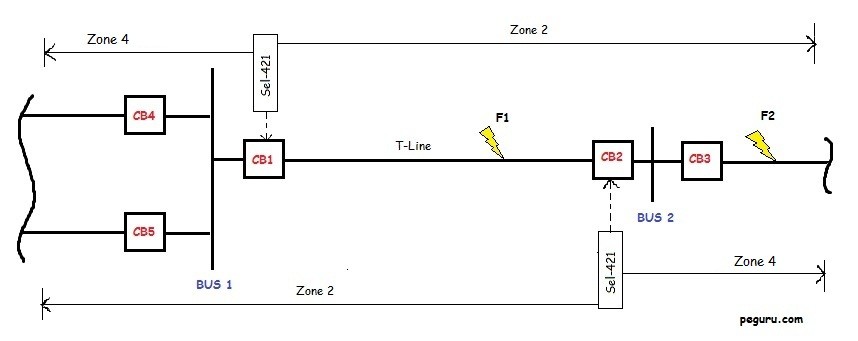The DCUB Scheme, like POTT Scheme, uses two frequencies to maintain system protection. When the system is operating under normal conditions, the transceiver emits the “Guard” or block frequency. When a fault appears in the system, the distance relays shift the carrier to “Trip” or unblock frequency. This is where the similarities between POTT and DCUB schemes end.
Unlike POTT, the DCUB scheme permits the breakers to trip when the block signal from the remote-end relay is lost. Ofcourse, there are certain conditions that need to be met before this happens. Let’s understand them using the logic and the figure shown below.
High-Speed Tripping Logic for DCUB = Fault in Zone 2 AND blocking signal removed AND unblocking signal received.
DCUB Trip Scenario No. 1: Fault in the zone of protection (F1)
- Pilot relays at CB1 and CB2 will see a loss of block frequency and receive the un-block frequency.
- Protective relays see zone 2 distance elements pick-up.
- Reverse looking zone 4 elements do not pick-up (optional setting).
- Both breakers – CB1 and CB2, trip (based on logic mentioned at the beginning).
DCUB Trip Scenario No. 2: Fault outside the zone of protection (F2)
- Relay at CB1 sees the fault using zone 2 elements.
- Pilot relay at CB1 shifts carrier from block to un-block frequency.
- Relay at CB2 does not see a fault in its zone. Therefore, the pilot relay maintains block frequency towards CB1.
- When configured in the relay, reverse looking zone-4 element too will key the block frequency towards CB1.
- Because of the block frequency from CB2 relay, CB1 is prevented from tripping (based on logic mentioned at the beginning).
DCUB Trip Scenario No. 3: Fault in the zone of protection (F1) but the block/unblock signal is shorted-out by the fault
- Both pilot relays see a loss of block frequency.
- Unblock frequency is not received either.
- Relays initiate a 150ms timer known as “unblock” window which allows tripping on the loss of the pilot channel.
- The fault is picked up by the zone 2 elements of both relays.
- Breakers CB1 and CB2 are tripped.
- On the other hand, if the fault is not picked up and the 150ms window closes, tripping is blocked.
It is this last extra bit that makes this scheme viable on a Power Line Carrier. It gives the dependability of a blocking scheme while providing the security of a POTT scheme.
This article, part of a series, covers the essentials on pilot relaying and pilot protection schemes. If not done already, start at the beginning.
- Basics of Pilot Relaying & Application Considerations For Transmission Line Protection
- Directional Comparison Blocking Scheme (DCB)
- Permissive Overreaching Transfer Trip Scheme (POTT)
- Directional Comparison Un-Blocking Scheme (DCUB)
- Direct Transfer Trip Scheme (DTT) (This is technically not a pilot scheme but requires a pilot channel)


Scenario 2: CB2 does not see a fault and sends gaurd frequency towards CB1 (NOT CB2). More over reverse looking element Zone 4 picks up to block trip.
Good catch. Updated the wording.
After further investigation, I think you’re right Dave. In case of channel loss, a 150 ms window is
open when permissive signal is bypassed and Z2 is allowed to trip high speed. His notes are incorrect above. Thanks for pointing this out.
Good catch. Updated the wording.
There’s actually always a timer, he only mentions it in the 3rd scenario because it’s more relevant in that scenario. To answer your question, his wording is correct. Both relays will trip their end’s breaker after the timer expires “IF” zone 2 elements still detect a fault.
For scenario #3, I am thinking that the relays are permitted to trip during the 150 milliseconds. After the timer elapses, tripping is blocked. Am I misinterpreting or should the wording be changed? Thanks!
Good catch. Updated the wording.